Cut flowers are a staple of many households and events, adding beauty and color to any space. However, have you ever stopped to consider the journey these flowers take before reaching your vase? From the moment they are harvested to the time they arrive at your local florist, cut flowers undergo a complex process that involves multiple stages and players.

The journey of a cut flower begins on a farm, where it is carefully grown and tended to until it is mature enough to be harvested. Once the flowers are ready, they are carefully cut and placed in buckets of water to prevent wilting. From there, they are transported to a packing facility, where they are sorted, graded, and packaged for shipping to their final destination. This process involves careful handling and attention to detail to ensure that the flowers arrive at their destination in the best possible condition.
The Life Cycle of a Cut Flower
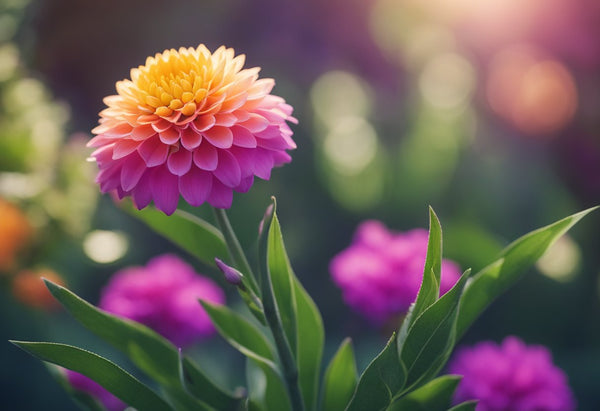
Cut flowers are a popular decoration in homes and events. However, have you ever wondered about the journey of a cut flower? From its germination to blooming, a cut flower goes through a series of stages before it reaches your bouquet.
Germination
The life cycle of a cut flower begins with its germination. The germination process is initiated when the seed is exposed to water, warmth, and oxygen. The seed absorbs the water and begins to swell, which triggers the growth of the embryo. The embryo starts to develop roots, which anchor the plant into the soil and absorb water and nutrients. The stem and leaves start to grow, and the plant begins to photosynthesize, producing energy from sunlight.
Growth
As the cut flower continues to grow, it goes through a series of stages. The stem and leaves continue to elongate, and the buds start to form. The plant continues to photosynthesize, which provides energy for the plant to grow. The stem becomes thicker and stronger, allowing the plant to support the weight of the flowers.
Blooming
The final stage of the life cycle of a cut flower is blooming. The buds start to open, revealing the flower's petals. The petals are brightly colored and attract pollinators, such as bees and butterflies. The flower produces nectar, which provides food for the pollinators. Once pollinated, the flower produces seeds, which can be used to grow new plants.
In conclusion, the life cycle of a cut flower involves the stages of germination, growth, and blooming. Each stage is critical to the development of the flower and its ability to produce seeds. Understanding the life cycle of a cut flower can help us appreciate the beauty and complexity of these plants.
Cultivation Techniques
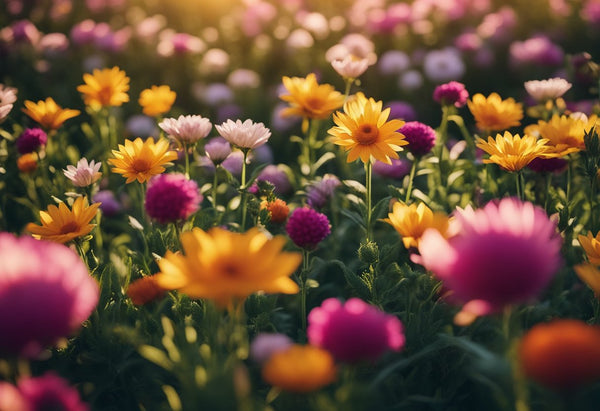
Soil Preparation
The first step in cultivating cut flowers is to prepare the soil. The soil should be well-drained, fertile, and rich in organic matter. Before planting, the soil should be tilled to a depth of 6-8 inches and amended with compost or other organic matter to improve soil structure and fertility. It is important to ensure that the soil pH is between 6.0 and 7.0, as this is the optimal range for most cut flowers.
Irrigation
Proper irrigation is essential for the growth and development of cut flowers. The amount and frequency of watering will depend on the type of flower, soil type, and weather conditions. Generally, cut flowers require 1-2 inches of water per week, either from rainfall or irrigation. It is important to water deeply and infrequently, rather than shallowly and frequently, to encourage deep root growth and prevent water stress.
Pest and Disease Management
Cut flowers are susceptible to a variety of pests and diseases, which can significantly reduce yield and quality. Integrated Pest Management (IPM) techniques should be used to manage pests and diseases, including cultural, biological, and chemical control methods. Cultural control methods include crop rotation, sanitation, and planting resistant varieties. Biological control methods involve the use of natural predators, such as ladybugs or lacewings, to control pest populations. Chemical control methods should be used as a last resort and only when necessary, to minimize the risk of environmental damage.
By following these cultivation techniques, growers can produce high-quality, healthy cut flowers that are suitable for use in bouquets and other floral arrangements.
Harvesting Methods
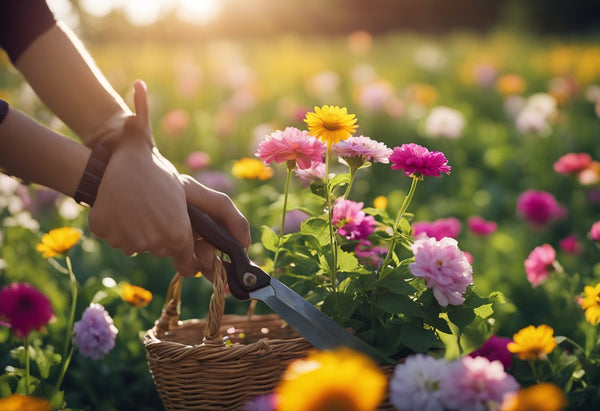
Timing
Timing is crucial when it comes to harvesting cut flowers. Flowers should be harvested at the right stage of development to ensure maximum vase life. Harvesting too early or too late can result in flowers that fail to open or wilt prematurely.
The best time to harvest flowers is early in the morning when the temperature is cool. This helps to reduce water loss and stress on the flowers. It is also important to avoid harvesting flowers when they are wet as this can lead to the development of fungal diseases.
Cutting Techniques
The way flowers are cut can have a significant impact on their vase life. It is important to use sharp, clean tools to make a clean cut that does not crush or damage the stem.
The stem should be cut at a 45-degree angle to increase the surface area for water uptake. Removing any leaves that will be below the water line in the vase can also help to prevent bacterial growth and prolong the life of the flowers.
Post-Harvest Handling
Proper post-harvest handling is crucial for maintaining the quality and longevity of cut flowers. Flowers should be placed in clean, cool water as soon as possible after harvesting.
Adding a floral preservative to the water can help to provide nutrients and prevent the growth of bacteria. Flowers should be kept out of direct sunlight and away from drafts to prevent wilting and damage.
Regularly changing the water and re-cutting the stems can also help to extend the vase life of cut flowers. By following these harvesting methods, cut flowers can make a successful journey from bud to bouquet.
Transportation and Logistics
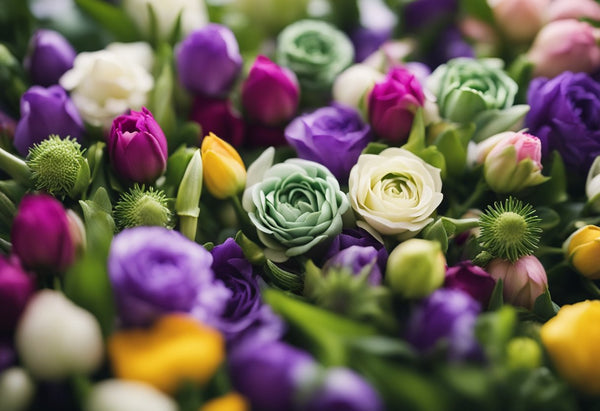
Cut flowers are highly perishable products that require careful handling to maintain their quality and freshness. Transportation and logistics play a vital role in the journey of a cut flower from the bud to the bouquet. This section discusses the key aspects of transportation and logistics involved in the cut flower industry.
Cool Chain Management
Maintaining the temperature of cut flowers during transportation is critical to their quality and shelf life. The cool chain management system is designed to ensure that the temperature of the flowers is maintained at the optimal level throughout the journey. The flowers are harvested and stored in temperature-controlled environments, and then transported in refrigerated trucks or containers to maintain the cool chain. The temperature is monitored at every stage of the journey to ensure that it remains within the acceptable range.
Packaging
Packaging plays a crucial role in protecting the flowers from damage during transportation. The packaging should be sturdy enough to prevent the flowers from being crushed, but also lightweight to reduce transportation costs. The flowers are usually packed in cardboard boxes with perforations to allow air to circulate and prevent moisture buildup. The boxes are labeled with information about the type of flower, quantity, and destination.
Distribution Channels
The distribution channels for cut flowers are diverse and complex. The flowers are transported from the farms to the auction houses or wholesalers, who then sell them to retailers or florists. The retailers or florists then sell the flowers to the end consumers. The distribution channels vary depending on the type of flower, the destination, and the season. The cut flower industry is highly competitive, and the distribution channels are constantly evolving to meet the changing demands of the market.
In conclusion, transportation and logistics are critical aspects of the cut flower industry. The cool chain management system, packaging, and distribution channels all play a vital role in ensuring that the flowers reach their destination in optimal condition. The cut flower industry is a complex and dynamic industry that requires careful planning and execution to ensure that the flowers are delivered fresh and beautiful to their destination.
Floral Design and Arrangement
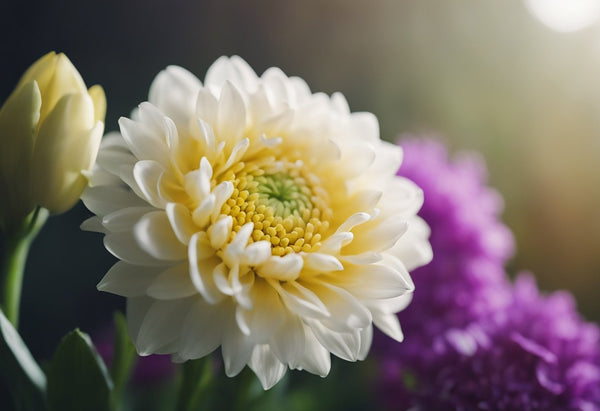
Selection Criteria
When selecting cut flowers for a floral arrangement, it is important to consider several factors. The first consideration should be the occasion or event. Different flowers and colors can convey different meanings and emotions, so it is important to choose flowers that are appropriate for the occasion. The second consideration should be the size and style of the arrangement. Different flowers have different stem lengths and shapes, so it is important to choose flowers that will work well together in the arrangement. Lastly, it is important to consider the season and availability of the flowers. Choosing flowers that are in season and readily available will ensure the freshest and most vibrant blooms.
Arrangement Styles
There are several different styles of floral arrangements, each with its own unique characteristics. Some popular styles include the traditional round bouquet, the cascading bouquet, and the modern minimalist bouquet. The traditional round bouquet is a classic style that features a tight cluster of flowers arranged in a circular shape. The cascading bouquet is a more dramatic style that features flowers arranged in a cascading fashion, with longer stems and more flowing greenery. The modern minimalist bouquet is a more contemporary style that features a few select blooms arranged in a simple and elegant manner.
Preservation and Care
Proper care and maintenance is essential for preserving the beauty and longevity of cut flowers. To ensure the longest vase life, it is important to cut the stems at an angle and remove any leaves that will be submerged in water. Flowers should be placed in a clean vase filled with fresh water and flower food. It is important to change the water every few days and to trim the stems every time the water is changed. Flowers should be kept away from direct sunlight, heat sources, and drafts. With proper care, cut flowers can last up to two weeks or more.
Market and Industry Trends
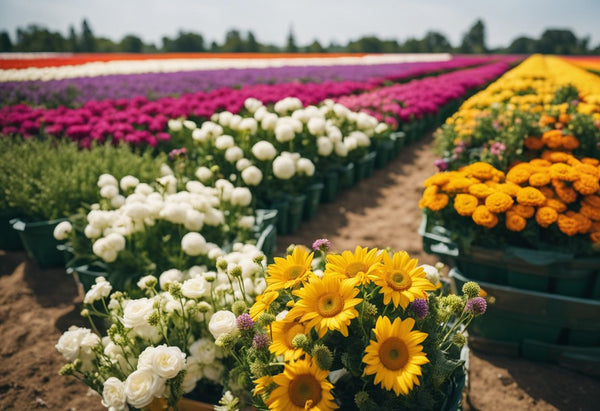
Consumer Preferences
As the cut flower industry continues to grow, consumer preferences have shifted towards locally sourced and sustainably grown flowers. Customers are increasingly interested in the origin of their flowers and the environmental impact of their production. In response, many florists and retailers are now offering locally grown flowers or those that are certified as sustainable.
In addition to sustainability concerns, consumers are also showing a preference for unique and exotic flowers. This has led to an increased demand for flowers from countries like Ecuador, Colombia, and Kenya, which are known for their diverse and exotic flora.
Technological Advancements
Advancements in technology have greatly impacted the cut flower industry. One such advancement is the use of hydroponic systems for growing flowers. Hydroponic systems allow flowers to be grown in a controlled environment, which can result in higher yields and better quality flowers.
Another technology that is gaining popularity is the use of drones for flower delivery. Drones can deliver flowers quickly and efficiently, reducing the need for traditional delivery methods.
Sustainability Practices
Sustainability has become a major focus in the cut flower industry. Many growers are implementing sustainable practices, such as using natural pest control methods and reducing water usage. Additionally, there has been a push for more eco-friendly packaging options, such as biodegradable and compostable materials.
Certifications, such as the Rainforest Alliance and Fair Trade, are also becoming more common in the industry. These certifications ensure that flowers are grown and harvested using sustainable and ethical practices, which is becoming increasingly important to consumers.
Overall, the cut flower industry is evolving to meet the changing demands of consumers. With a focus on sustainability, technological advancements, and unique offerings, the industry is poised for continued growth in the coming years.
Cultural Significance of Flowers
Symbolism and Meaning
Flowers have been used as symbols of love, friendship, and mourning for centuries. Each flower has its own unique meaning and symbolism. For example, roses are often associated with love and passion, while lilies symbolize purity and innocence. In some cultures, certain flowers are used to convey specific messages. For instance, in Japan, cherry blossoms are a symbol of the transience of life.
Global Traditions
Flowers play a significant role in many cultures and traditions around the world. In India, marigolds are used in religious ceremonies, while in China, chrysanthemums are a symbol of autumn and are often used in artwork. In Mexico, the Day of the Dead is celebrated with colorful floral arrangements and offerings.
Floral Events and Exhibitions
Flowers are also celebrated through various events and exhibitions. The Chelsea Flower Show in London is one of the most famous flower shows in the world, showcasing beautiful floral arrangements and gardens. The Rose Parade in Pasadena, California, is another popular event that features elaborate floats covered in flowers.
Overall, flowers have a rich cultural significance and are used to express a wide range of emotions and messages. From weddings to funerals, flowers play an important role in our lives and traditions.



